
Ancient Armenia |
DEVELOPED MIDDLE - AGES
AMBERD
|
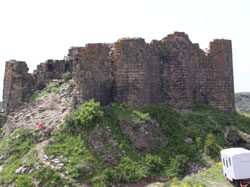
|
Amberd is a fortress complex with
a church built on the
eastern slopes of
Aragats
Mountain at 2,500
meters above sea level in the XI-XIII centuries.
The special strategic position
and the hard building efforts of mighty princes of their time Phalavunis,
Zakaryans and Vachutyans make Amberd as a work of war fare art. The prince
palace was in this fortress too. |
|
The fortress is still
standing and it makes a great impression on tourists. It is extraordinary
impressive: the view opening from the palace's windows on the ice tops of
Ararat Mountain and Araratyan Valley. The palace is three-storeyed.
|
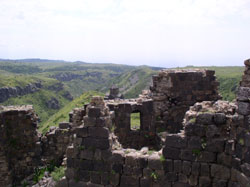 |
|
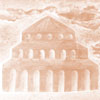
7 wonders of Armenia |
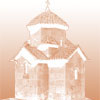
Early Middle-Ages |
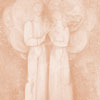
Ethnography |
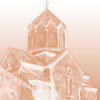
Developed
Middle-Ages |
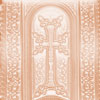
Stone symphony |
|
Tours
News
Contacts |

Natural wonders |
|
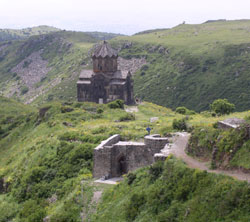
|
On the 1st floor has armory
and water reserves. In Amberd are persisted baths outside the palace. During
the excavations of the baths were found graceful bronze faucets for hot and
cold water.
None of the conquerors
succeeded to capture Amberd. It is the unbreakable symbol of Armenian
mountainous spirit. |
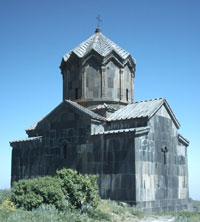
|
AKHTALA
“Titan’s country”, mountain
island, country of rivers, in these words is characterized Armenia and these
words become more typical, when we visit Lory. Characteristic word referring to
Lory-dweller “ the braves of Lory” is spread among people till today.
Almost all fortresses were
protected only by one side, whence the castle incorporated to land, in other
three sides the Armenians have never built a fencing, because they were
naturally
protected by 150-500 m rocks descending to precipice.
Here in this legendary place
situated celebrated fortress in Armenia, Akhtala, on the top of the rock arising
through the gorge of Debed. Akhtala, which is on the flat crest of the
triangularly shaped rock with only one gate, is unique and inexplicable
military-architectural building in the world. Huge gate and thirty meter tower
on it, with special attractive phenomenon create a fantastic recognition, which
can be explained as “military grandeur”.
This fortress was a powerful
strategic point for the empire Kyurikyan Bagratuni formed in tenth century,
where was saved the state exchequer. After it in thirteenth century prince Ivane
Zagaryan have more strengthened the castle transformed it into the military
pride of Transcaucasia.
Near to the
fortress there is a church St.Grigor, which by the order Ivan Zagaryan was
reconstructed by Kakhkedon style and till now with the well preserved frescos is
the conduct of the medieval Armenian applied art.
BJNI
FORTRESS
Bjni Fortress is situated in Hrazdan
river gorge 54km far from Yerevan. The particularity of Armenian fortresses is
that almost all fortresses are in capes surrounded by huge gorges and mountain
rivers and as opposed to European fortresses almost all Armenian fortresses only
in one side protecting walls in other 3 sides are protected by capes of 150-200m
depth.
These principles of construction are
in Bjni fortress. The fortress mainly was built by Grigor Magister Pahalvuni in
1031 in Bjni village. That huge rock rising up from the cave is a perfect
natural fortress. Grigor Magister surrounded it in one side by two rows of
mighty wall of 15m height. The wall in every 10m has a tower. The walls of this
fortress have been standing for centuries, many armies fell down at these walls,
and it will stand for more than thousand years – the result of Grigor
Pahlavuni's talant.
EGHEGIK
Eghegik, 10-13 centuries Siunats
Orbeilyan count’s residence is situated in Vayots Dzor 150 km south- east from
Yerevan.
The fortress and the city are still
standing and astonish everyone with its indescribable beauty. Sometimes
historians call it “Capital”.
There are marvelous buildings in
Eghegik from Orbelyans’ and Siunats’s times. The most beautiful among them is
the fortress, which is situated in the north-west of old city. The fortress is
surrounded by mighty ramparts, which have many turrets. Inhabitants say that the
fortress has been built by count Smbat, that’s why it is called Smabt’s fortress
There are four churches to mention
besides the fortress. In the north-west of fortress there is famous Tsakhatskar
church (10th century).
Eghegik fortress and Tsakhatskar
church are the union of attractive surrounding and human mind for the visitors.
GNDEVANK
Gndevank is
situated 175 km south-east from
Yerevan, in the
gorge of the Arpa river, in Vayots Dzor district. Vayots Dzor is one of the most
famous provinces of historical Armenia, real museum under the open sky.
During many centuries numerous Armenian princes, kings and foreign conquerors
have fought for locating their claims to that paradise province. Vayots Dzor is
mountainous, multiwater, warm place with fertile lands, which has a unique
beauty. That’s why it’s said that when God took the Paradise away from Earth, he
left one piece of it in Armenia, in Vayots Dzor.
Here, in this paradise, in the gorge of the Arpa river is situated wonderful
Gndevank. It was erected in 936 by queen Sopa of Syunik.
Gndevank was built in imitation to the temple Hripsime, but it has quite another
charm. In contrast to miracle of Hripsimeh, the splendor of Gndevank is
completed by the gorge of Arpa, which has 200 m depth. There is amazing harmony
between the gorge and the composition of the monastery ensemble.
In her time the queen Sopa presented the gorge of Arpa with its two villages to
the monastery and very soon it turned into a flowering garden, which amazes with
its perfect beauty till today.
A
bit later, in 996, in front of the temple was erected a gavit, which is the
oldest one in Armenia, among the buildings of the same kind. Gndevank is also
rich with carvings and is rare in Armenia in this conception.
GOSHAVANK
|
Goshavank, the most difficult
architectural complex of medieval Armenia, is situated on the edge of the
cave of the Areguni mountains 110 km far from Yerevan.
The monastery was founded by
Mkhotar Gosh in 1188 A.D., favored by Ivane Zakaryan. The monastery
ensemble consists of four churches, two chapels one jamatun, two storeyed
writing house, two academy buildings.
Its other name is Nor-Ghetik, as
it was erected in place of an older monastery, Ghetik, which had been
destroyed by an earthquake. But Mkhitar Gosh’s fame was so wide that the
monastery was calls Goshavank in his honor. |
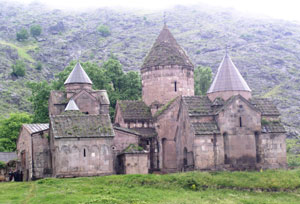
|
|
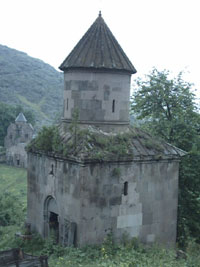
|
He founded a science academy in
Goshavank, in which was taught divinity, mathematics, music, writing,
miniature, architecture and law. Gosh was the first to write the criminal
code, which was used not only in Armenia, but also in Georgia, Egypt, etc.
One of his alumnis was historian Kirakos Gandzakeci, whose history is
admitted as the basic of Mongolian marches in whole world.
The monastery assemble with its
architectural majesty also has strange disproportionateness, because every
church of the monastery is built according to individual architectural
school laws. Maybe this is the reason why there are many legends connected
with the monastery starting from the architecture of the monastery, a.k.a.
“carpenter”, Mkhitar master ending with dreadful conqueror Timur the 1st.
|
|
Here is one of them: in 1375 A.D.
Timur’s army conquered Armenia. He was told about Goshavank and its riches.
Cruel Timur directed his troops to Goshavank, captured all the friars and
ordered to surrender all the riches of the monastery. The friars told him
that the monastery was poor and there were no riches. Timur got angry and
told that he knew the name of great Wiseman Mkhitar Gosh and that his
mausoleum was entirely of gold. Then he was shown his modest mausoleum.
Furious Timur ordered to bring all Armenian captives and to burn their
children in front of their eyes. There is still the square and Timur’s stone
throne, on which Timur was going to watch Armenians to surrender their their
riches for their children. But the Armenians stood firm. At that time one of
Timur’s generals advised him to burn all the manuscripts of the monastery
academy. And then happened unexpected thing. Armenians promised to tell the
place of the riches. |
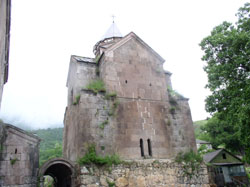
|
|
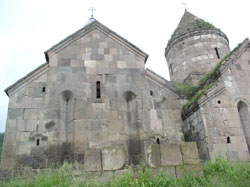 |
Surprised Timur called one of the
villagers and ordered him to read the manuscript. The villager said he
couldn’t read. Timur asked what was in the manuscripts that they surrendered
the riches. The villager answered that there was the history of their
nation, idea and belief.
It is said that Timur didn’t burn
the manuscripts, took the riches and left but where no one can say.
|
HAGHARTSIN
|
The monastery
complex of Haghartsin, X-XIII centuries, is situated 110 km from
Yerevan, in
the territory of Dilijan state enclosure.
The complex
consists of four churches, two narthexes, refectory and other buildings. A
unique luxury and magnificence is given to Haghartsin by the surrounding
woods with their virgin beauty. Gorges of abyss’s height, huge mountains
covered with woods and a complete uninhabited territory, which even creates
mysterious environment.
And after all
this, before the look of the tourist, stands Haghartsin, a single model of
architectural forms and slender lines, which is combined with the surrounding
green. This is the harmonious alloy of the Armenian taste of form and
nature. And it’s not surprising that two Armenian kings have found their
rest in the monastery complex of Haghartsin. |
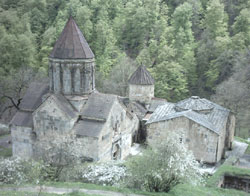
|
|
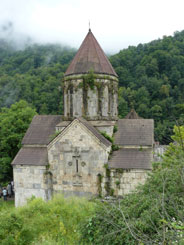
|
However, the
remarkable building of Haghartsin is its secular refectory the masterpiece
of 1248 of the architect Minas, a unique achievement of the engineering mind
of middle-ages, where the huge cover (21.6m x 9.6m) stands on just 2
columns. It’s already thousands old years that such flight of Armenian mind
draws a lot of tourists and visitors with irresistible temptation. |
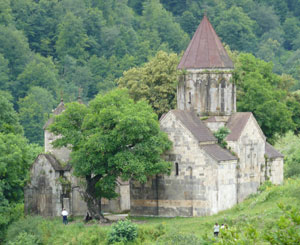
|
SANAHIN
|
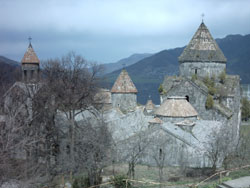
|
Sanahin, the glory of medieval
Armenia, is situated at a distance of 170 km from Yerevan in the area of
Alaverdi town, in Deped gorge.
Sanahin monastery assemble
consists of two churches, jamatun of 10th century, academy
building of 11th century, book depository of 1063 gallery of 10th
century, gavit of 1181, chapel of 13th century, a bridge of
1192.
|
|
The exact date of the
construction is unknown, but in 10th – 11th cc the
number of monk union was already over hundreds. In this period Sanahin
became the largest centre, and the school became an academy. In history it
is known as Grigor Magister Pahlavuni Academy. In this academy was paid
attention to humanities. The most famous alumnis of this academy were
Teodoros, Anania. In 13th century in Sanahin was a medical
school, in which were taught internals, biology and physiology.
|
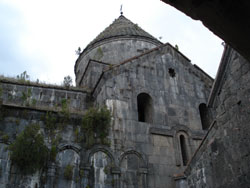
|
|
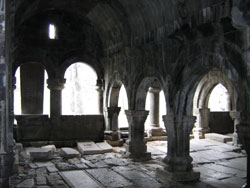
|
The main church built by
Khosrovanuish, the wife of Ashot the 3rd Voghormats as goodwill
to her sons Smbat and Kyurike. Unlike to Armenian other churches this are
the largest. Despite of its huge sizes the cupola with its harmony makes an
impression of lightness on the visitor. The interior attracts with its
arches of the cupola and especially with its huge torch with 112 waxies
which are made of copper and decorated with silver embroiders.
The book depository is unique. In
its sizes it is the largest book depository in Armenia. Every niche is
decorated in the nation or religion style, in which language are written the
parchments in that niche. On the north wall of the depository there is a
tribune from outside, the 1st open air tribune in the world. It
is of 1.5m height and near to the wall, so speaker could be seen and
protected from the auditorium. The glory of Sanahin is tightly connected
with Hovhanness Imastun (Wise) 13th century. He was famous
chronologist, divine and mathematic. The legend says that he closed himself
in the chapel and had been reading for days forgetting about food and water. |
|
In the area of Sanahin monastery
there is a family cemetery of Zakaryan princes, who were governors of
Transcaucasia in 12th – 13th cc.
We also should mention the
architect of this wonderful monastery – Grigor Tutevordi.
In Sanahin everything is in
harmony: art, engineering, architecture. In Sanahin were born Loris-Melikov
(1876-80) Russian general and Artyom Mikoyan – famous aircraft designer and
Anastas Mikoyan, The president of Supreme Council of Soviet Union.
|
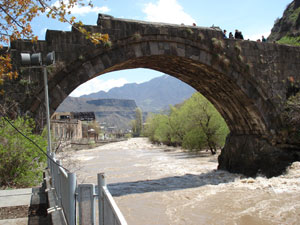
|
HAGHPAT
|
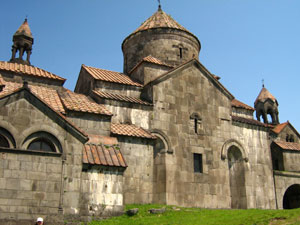
|
Haghpat is one of the largest
architectural assemble of medieval Armenia. It consists of three churches,
jamatun-gavit, chapel, refectory, book depositary and galleries.
The whole assemble is remparted
and it is on the east slope of Bazum mountains.
The location of Haghpat is
entirely harmonized with its surrounding: the gorge of 200m depth near Deped
River, huge mountains covered with forests.
|
|
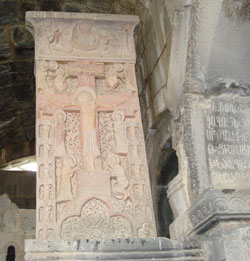
|
The main church of the assemble
St. Nshan was constructed in 10th century by order of Ashot the 3rd’s
wife Khosrovanush in 976-991 AD. It is distinguished by its compactness and
harmoniously balanced shaped crowned with a tremendous dome. In the interior
the fancy shape of the high cupola abutments, protruding to the centre, is
smoothly combined with high arches, resting on them and changing over from
semicircular to the pointed shape. There is some information that St. Nshan
church had been built by Trdat, the genius of worldwide architecture.
|
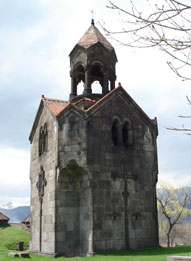
|
|
Haghpat was also a large science
centre of its time. There have been written many parchments, which are now
in Matenadaran, especially Makar’s The Gospel book, with miniature of
Haghpat School written in 1211.
We can separate from Haghpat
assemble “Hamazasp’s House”, the largest secular building in Armenia. This
is a rectangular structure in the plan with four inner abutments and the
arches beginning from them and crossing the centre, form octahedron central
part. The squat proportions of the building and its architectural details
create the impression of interior and exterior heaviness.
And near all - this unimaginable
gentle Khachkars.
|
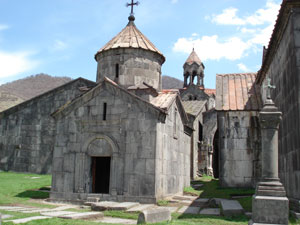
|
MAKARAVANK
Makaravank is situated at Achajur
village of Tavush district 150km far from Yerevan, The monastery is on the top
of Paitatap Mountain surrounded by mighty ramparts and oak woods.
The monastery is built of dark pink
andesite, tuff and occasional greenish stones. All this create artistic
incredible view. Everything breathes antiquity, even the cold water in the front
of the monastery gates.
The monastery consists if three
churches, one gavit, one jamatun and other serving premises, and also the
ramparts and outside monument. The oldest church of the monastery is of 10th
century and the main church was constructed in 1204, gavit - in 1207, St.
Astvatsatsin (Mother of God) in 1198. Makaravank belongs to domed hall
architectural style as the majority of Armenian monuments.
We should mention that none of
churches in Armenia is alike to each other in architectural style.
The main church of Makaravank is with
carved drum with mighty dome. The walls of altar daises, decorated with
geometrical ornaments are of extraordinary interest. The ornaments feature
various floral motifs making up unusual bouquets and all kinds of fishes and
birds and also a man sitting in a yawl and a note near it – “eritasard” (fellow)
– probably the self-portrait of the carver. The exterior and interior of the
church are skirted by graceful arch arcature on twin half-columns.
Makaravank is also unique for its
light with round and square windows, but each window is ornamental masterpiece.
MARMASHEN
|
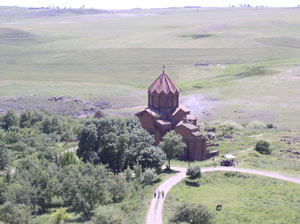
|
Marmashen monastery is 120 km
far from Yerevan to the
northwest of
Gyumri,
this monastery has four churches (one of which, circular, has only recently
been discovered with a jamatun and a chapel); the jamatun and the chapel
are nearly in ruins. An inscription on the south wall of the main church
informs us that it was built between 986 and 1029 by Prince Vahram Pahlavuni.Marmashen
monastery is also called Vahramashen. Vahram Pahlavuni was an Armenian
general during the last period of Bagratinu kings. A famous general, which
in 1045 defeated Byzantine army near Ani.
Of cupola's hall type with an umbrella shaped cupola, the church is
constructed of huge stones, some of which are two meters high. Three of the
exterior walls have double niches. The only entrance is on the west. Like
the exterior walls, the drum of the cupola is adorned with half columns,
which produce a beautiful decorative effect. |
This impressive monastic complex sits
on a picturesque shelf with fruit trees above the Akhurian River, beside a
stream that ends in a waterfall.
The hills around are gold covered by corn fields and the monastery is surrounded
by apple gardens.
|
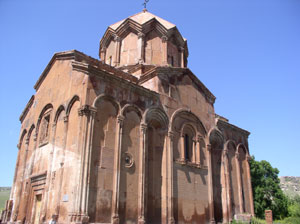
|
Every man, that is a little
bit painter in hid soul, can't be indifferent towards this view. Every
visitor is admired by the carvings of the church, by the shine of the
Armenian tuff and also thinks at the mausoleum of the legendary general.
Maybe this is the only case when the real life becomes a legend during the
life and eternalizes to another genius-Tiridat's created fairy-tale. |
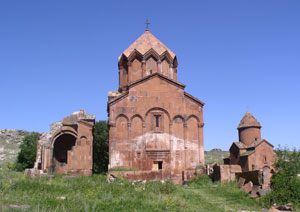
|
HOVHANNAVANK SAGHMOSAVANK
|
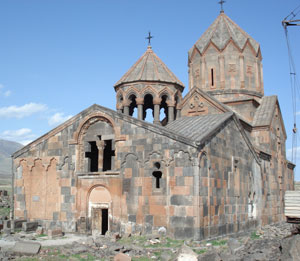
|
Hovhannavank and Saghmosavank are
25km and 30km far from Yerevan on the large edge of gorge of Kasakh river.
It is unknown till now why these
two monasteries are constructed so close to each other. Both monasteries
have been constructed by Prince Vache Vachutyan and his wife Mamakhatun in
1215-1221.
Hovhannavank
was constructed near a church of 5th century, but neither the
monastery nor the cupola in their architectural style is alike to other
Armenian architectural style. Speaking about the cupola of Hovhannavank we
must mention that despite of its cover leaning on four mighty abutments, the
construction seems like repeating shape. But there is something interesting:
the cupola is covered by unique rotunda. The south and west walls are
decorated with huge and gorgeous windows. The cupola
reminds more an emperor palace that a church.
|
|
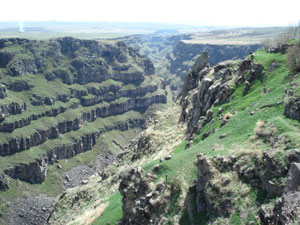
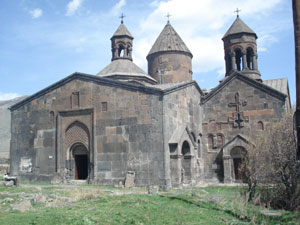 |
None of Armenian churches has so
magnificent entrance as Hovhannavank. Round the entrance is carved Jesus Christ
and a fable. The church has cross bases and is centre cupolad, entirely carved.
In this church seems like everything is hung from the sky.
Saghmosavank unlike to
Hovhannavank is more modest in its shape, but the whole interior of
Saghmosavank serves to the science and art.
The book depository and the
school of Saghmosavank have been one of the famous depositories in medieval
times. The depository is architectural unique building in Armenia.
Interesting is that the depository is a church and hiding place meantime. In
this monastery have been written several Armenian worthy inscriptions
referring to medicine, philosophy, divinity and natural sciences. |
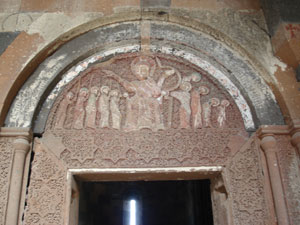
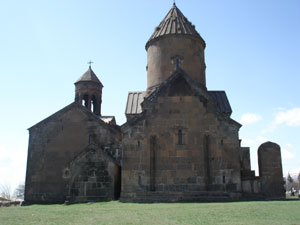 |
The monastery in its laconic
style makes a mysterious impression on the background of legendary Arai
Mountain and Kasakh gorge.
TATEV
|
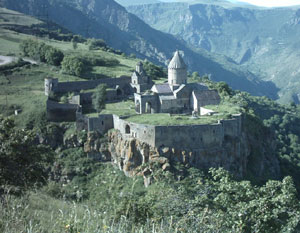
|
Tatev monastery assemble is
situated to the south-west of Yerevan 215 km far from it. The monastery is
on the gorge edge of Vorotan river (the deepest gorge in Armenia: 500m). The
monastery is surrounded by high and thick ramparts and towers.
It was built in 885. Due to
its inaccessibility Tatev was the largest religious and science centre of
medieval Armenia. Everything is wise and mysterious in Tatev.
The main – Poghos-Petros (Peter
and Paul) church is a representative of cupolad hall architectural style,
but this church is famous for its frescos, where was representation of The
Last Judgment 600 years before Mickaelangelo’s Sistine Chapel. |
|
One of the wonders of Tatev is
the waving crook of 6m height. It has been standing for over 1200 years (895
AD). There are many legends connected to this crook. One of them is that it
is waving by itself when enemies are coming to Armenia.
Tatev monastery is also the
richest assemble in Armenia. We even can say that it was a state inside of a
state. In Armenia over 700 villages were the properties of the monastery.
The monastery invested all the riches in education.
The glory of Tatev was its famous
university of 14th century AD. In this university were taught
such worldwide geniuses as Hovnan Vorotnetsi and Grigor Tatevatsi. In
natural sciences and philosophy the world science considers Grigor
Tatevatsi’s works as a basis. In philosophy he wrote the famous “The
quarrels” (imagining the quarrels with Aristotle). He was the first to prove
that “the movement” is the basis of everything. Armenian Church has
sanctified Tatevatsi. He is buried in Tatev monastery. In Armenian churches
it is forbidden to be buried in the church, no matter who he was. Only
Mesrop Mashtots and Grigor Tatevatsi are buried in the church. |
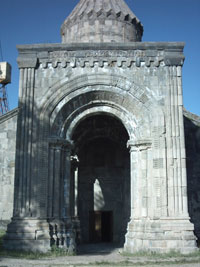
|
TEGHER
|
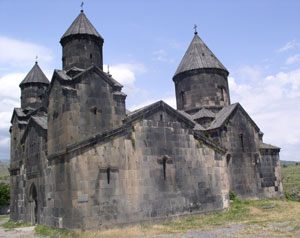
|
On the slope of Aragats mountain,
on the 3000m height from sea level, there is one of the mysterious monuments
of Armenia – Tegher monastery, 50km far from Yerevan (1220-1223). This
monument consists of St. Astvatsatsin church and gavit with two churches
erected on its roof, which has no entrance, though they are built according
to the all churchbuilding laws.
In this mysterious building there
are mighty Prince Vache Vachutyan’s and his wife’s Mamakhatun’s graves and in
the southern part is buried the architect Aghbayrik. In our history it is
learnt a little about this architect, but he deserved much respect owing to
his unique role in Armenian architecture.
Tegher is surrounded by mighty
walls, which have been recreated in 1468. Near Tegher is the famous Byurakan
observatory and the space rays research mirror- the 2nd mirror by
its size in the world with 50m diameter. |
KAGHENI FORTRESS
Armenian capital
Ani protecting this huge inaccessible fortress is still standing on the bank of
Akhurian river. Its 25m height tuff towels raise from the golden field. The
fortress is with quadrate secant, in the corners with four circular turrets. The
fortress has the second row of rampart, but it is lower than the first and it is
injured. Inside the fortress there are two-storeyed economical building and
store-rooms. Both Bagratunies and foreign conquerors appreciated the might and
the inaccessibility of Kagheni fortress.
|
![]()

![]()